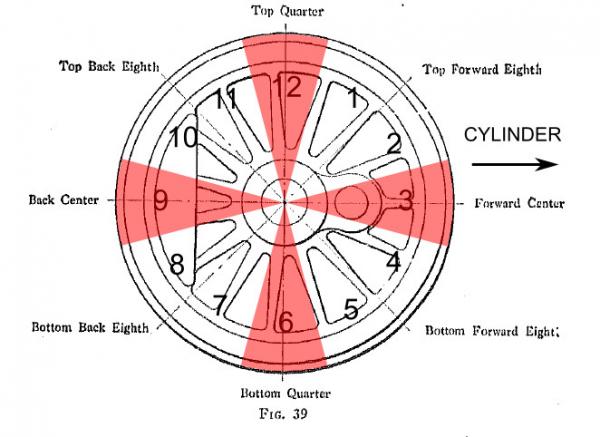Hello, Phillip.
Quote
:good:
I suppose, this is totally right and true:
Quote
Instead of the throttle setting a target pressure for the steam chest, the throttle controls the flow rate into the steam chest, which will eventually achieve boiler pressure regardless of how little the throttle is opened (assuming no steam is consumed).
The pressure can be lower, but only if the flow after regulator will be greater, than through regulator's opening, all it's way further. See
Bernoulli's law. (in short, the energy of heated steam are existing in three forms: pressure, speed and internal. Higher speed - lower pressure and vice-versa. In thinner openings, pressure turns into speed, in cameras (our chest, when no steam used) - speed is zero, so the pressure is maximal, internal energy is only being decreased, due to hydrawlic resistance of piping and due to cooling, but later I'll tell, how it can be utilized for useful work).
In other cases, the most "thinner opening" between boiler (maximal pressure's value, "full") and athmosphere (the "zero" pressure) will determine resulting pressure. Note, I've substituted "minimal" word to "zero", because inside thin opening itself, pressure will be less, than athmospheric - having the negative value. This causes
ejection effect, which is known to be used for vacuum generation, e.g. for brakes in British-type railroad brakes.
So, I'd correct Your last conclusion (do You mind?):
assuming less steam, than regulator currently passes, is being consumed.
Quote
At low speeds, most of the throttle is a deadzone where applying more throttle doesn't actually give more steam, but at high speeds the entire throttle is useful.
I think, this is to be wrong. And here is the cause of crazy wheelslip's possibility, once tractive effort exceeds adhesion - just open regulator a little more. It will form "deposite of energy" in chest, which will blow-oute, once slipping occurs.
I continue:
Quote
This changes the driving methodology as at low speeds the throttle cannot control tractive effort directly
is intended for this. Generally, yes: biggest cutout means, the steam works in cylinders without expansion (i.e. freeing-out it's internal energy), but only by means of constant and almost equal steam chest's and cylinder's pressure (it will be passed by piston to crank, causind whell to turn). At low speeds, where inertia of rolling locomotive can't move pistons and valves all their travel long (whole wheel's turn), this is only the way for engine to complete it's working cycle. But in greater speeds, driver can reduce cut-out time, so portion of steam, locked in cylinder under higher pressure, can expand, utilising more of it's internal energy (pressure drops, internal energy is being used during expansion), and the process of expansion turns from isobaric to adiabatic (see these terms, if not familiaf - for physics details and formulae).
See also
Hence,
Quote
In fact, most throttle settings will get the steam chest right up to full pressure unless the cylinder cocks are open to let steam out.
Yes and no: in case of movement takes place, steam usage in form of pulsation does take place.
Quote
Closing the throttle doesn't immediately reduce the steam chest pressure as the steam in there sticks around until it's consumed by the cylinders.
True, as well, as an opposite: regulator's opening doesn't cause immediate maximal effect: time needed for pressure in chest to grow-up. (my greetings to Sanjay)
Quote
Because the throttle controls flow rate, the average chest pressure at a given throttle and speed will depend on steam outflow, so lower cutoff settings give higher chest pressure as steam will be consumed slower.
Indeed!
wikipedia said:
greatest power is achieved by keeping the inlet valve open throughout the power stroke (thus having full boiler pressure, minus transmission losses, against the piston throughout the stroke) while peak efficiency is achieved by only having the inlet valve open for a short time and then letting the steam expand in the cylinder (expansive working)
The point at which steam stops being admitted to the cylinder is known as the cutoff, and the optimal position for this varies depending on the work being done and the tradeoff desired between power and efficiency. Steam engines are fitted with regulators (throttles in US parlance) to vary the restriction on steam flow, but controlling the power via the cutoff setting is generally preferable since it makes for more efficient use of boiler steam.
I'd add, that in local tradition, it was accepted to state, that superheating the steam have proven to bring same efficiency, than compound engines, but by more simple, light and perfect way, because it, in addition, have allowed to take more heat from fire and to make steam dryer. So, compound locomotive were cuccessed by simple superheated.
Quote
if the locomotive is superheated, is the throttle before or after the superheater?
I think, before: it's inside boiler (under the steam dome) and protects thin superheater's pipes from being under full boiler pressure all the time. There are some very good scanned books about steam locomotive's design, but they are not in English. However mr.Newell (a.k.a. steamer_ctn) have managed, how to read them.
 darwins, on 22 April 2024 - 11:24 AM, said:
darwins, on 22 April 2024 - 11:24 AM, said:
 Log In
Log In Register Now!
Register Now! Help
Help













